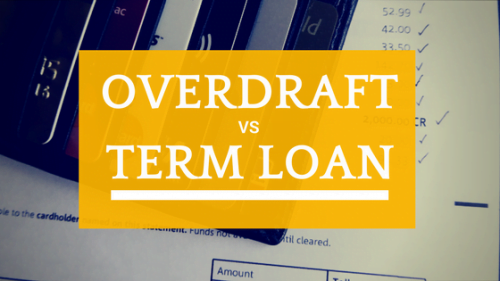
For every business to flourish, they need to acquire funds at a reasonable rate whenever required. So, when it comes to funding, there is no single approach that fits all. Every business has its own funding needs and requirements and can look for different financing solutions like overdraft loan or term loan. Even the financial institutions offering these funds have their own set criteria, funding amounts, terms, and conditions. Therefore, individuals and small businesses who are looking to borrow money from lenders can either go for overdraft loans or term loans.
Also Read: 4 Best types of quick, short-term business loans that every business owner should know
Differences Between Overdraft Loan and Term Loan
Table of Contents
- 1 Differences Between Overdraft Loan and Term Loan
- 2 Overdraft Loan Or Term Loan – A Detailed Explanation
- 3 Term Loan
- 4 Term Loan for Small Businesses and Individuals
- 5 Eligibility Criteria
- 6 Documents Required
- 7 Advantages of Taking Term Loans
- 8 Disadvantages of Term Loans
- 9 Advantages of Overdraft Loan
- 10 Disadvantages of Overdraft Loan
- 11 Which is Better?
| Basis | Overdraft Loan | Term Loan |
| Meaning | Overdraft loan is a facility through which a customer is authorised to withdraw funds from the current account, even if the balance is zero; but only up to a certain limit. | Term loan refers to a loan where a fixed amount of money is borrowed for a specific period. This money is to be paid back with interest. |
| Security or Collateral | In the case of overdraft facilities, no security or collateral is required. | Term loan can be both secured and unsecured. |
| Process | An overdraft facility can be availed easily, as it does not require much paperwork and the amount is readily available. It is a one-time process. | In the case of a term loan, minimal documentation is required and disbursal is easy. |
| Time | These are short-term funds. | These are long-term funds. |
| Usage | It is a credit facility, and thus, good for fulfilling working capital requirements like wages, bill payments, etc. These are also considered as emergency funds. | It is a borrowed capital and can be used for the expansion of businesses like purchasing machinery, building, construction, payment of debts, and can also be used for working capital requirements like bill payments, etc. These are considered as pre-planned funds. |
| Rate of Interest | Here, the interest is charged on the borrowed amount, i.e., only on the amount being used, not the entire amount. | Interest is charged on the entire borrowed amount, whether it is being used or not, until the amount is repaid. |
| Interest Calculation | In the case of an overdraft, the interest is fixed, not fluctuating. | Whereas, in the case of a term loan, the interest is calculated every month. |
| Current Account Holder | In the case of an overdraft loan, it is not mandatory to have a current account. | In the case of a term loan, it is mandatory to have a current account. |
| Repayment | In this case, repayment is made through bank deposits. | In terms of the loan, repayment is made either on-demand or through monthly installments. |
| Credit Facility | This is a credit facility offered by financial institutions having different terms and conditions on which interest is charged. | The same is the case with term loans. |
| Limit | Here, different credit limits are assigned to different customers, and any required amount can be withdrawn within the limit. | In the case of a term loan, the amount cannot be modified, and the customer can avail only the sanctioned amount. |
Also Read: Merchant Capital – A Shot In The Arm To Small Businesses That Require Working Capital
Overdraft Loan Or Term Loan – A Detailed Explanation
Small businesses or individuals can opt for either, depending on the needs and requirements of the business. But before jumping to any conclusion, they must first understand the pros and cons of both.
Term Loan
A term loan is a fixed amount of money sanctioned by a lender to a customer for a specific period on a secured or unsecured basis.
Term Loan for Small Businesses and Individuals
As these are long-term funds taken for a long period, the loan can be used for various purposes like the expansion of business, purchasing machinery, raw material, building, payment of rent and salaries, etc.
Now, before applying for a term loan, the businesses and individuals are required to fulfill the following criteria:
Eligibility Criteria
- The applicant should have a good credit score.
- The applicant should have a regular income source.
- The applicant’s age should be minimum 21 years while applying for the loan, and a maximum of 65 years at the time of maturity.
- The turnover criteria varies from bank to bank.
- The business should be making profit for the past two years.
- For different loans, different sets of documents are required, which the borrower needs to provide at the time of loan application.
Documents Required
- Business registration proof.
- KYC documents of the applicant and the business.
- Bank statement for the last nine months.
- PAN card of the promoter.
- Aadhaar card of the promoter.
Advantages of Taking Term Loans
- A term loan is usually for a longer period, therefore, the rate of interest is lower as compared to short-term loans. The rate of interest is fixed and doesn’t vary during the tenure.
- The repayment is made monthly through EMIs, therefore, it doesn’t put a burden on the customer.
- Usually, the amount taken from the lender is higher, and thus, can be used for expanding the business.
Disadvantages of Term Loans
- Here, the amount cannot be modified like in the case of an overdraft, so the customer can only avail the amount sanctioned by the bank.
Overdraft Loan
Overdraft is a facility through which customers can withdraw money up to a certain limit, even if the balance in their accounts is zero. It is a short-term loan taken for a short period. An overdraft facility can be availed on a secured or unsecured basis.
Before applying for an overdraft loan, the applicant should fulfill the following requirements:
- Business registration proof.
- KYC documents of the applicant and the business.
- Bank statement for the last nine months.
- The applicant should have a minimum monthly income.
- They should have a healthy CIBIL score.
- The applicant should have a valid identity proof (PAN card/ passport/ aadhar card/ driving licence) and address proof (ration card/ passport/ electricity bill).
- Last three-month salary slips.
Advantages of Overdraft Loan
- For overdraft loans, less paperwork and document verification is required in comparison to term loans.
- If a business has incurred an expense or loss, it can immediately be met through the overdraft facility. It becomes safer in busy periods.
- There is a lot of flexibility involved in this case, as the loan can be taken any time, of any amount, up to the allotted limit.
- In this case, no collateral or security is involved against the loan.
- As it fulfills the small fund requirements of businesses, the process of availing this loan is easy and simple.
Disadvantages of Overdraft Loan
- This kind of loan is good to meet the small fund requirements, not large ones, as the rate of interest, in this case, will be a lot higher.
- A lot of fees and charges are involved in the case of overdraft loans. For example, if you want to extend the overdraft, an arrangement fee is charged.
Now, these advantages and disadvantages of both overdraft loan and term loan actually depend on the needs, requirements, and type of customers or borrowers. Both attract higher rates of interest, which actually differs from customer to customer, and tenure to tenure.
Also Read: All That You Need To Know To Successfully Manage Your Cash Flow As A Small Business Owner
Which is Better?
Answering which one is better depends on the circumstances and needs of the business, which differ in every case. There are certain situations where overdraft might fulfil the requirements, in that case, there’s no need to apply for a term loan, as it involves a huge amount, which can become a liability. On the other hand, there are certain expenses and needs that can only be fulfilled through a term loan. For example: if a business is looking for expansion or wants to purchase land or machinery then it can go for a term loan as the expenses involved here are huge and a fixed period is involved. Overdraft loan is often reviewed safe and easy to avail and is considered a better choice to meet small and minor expenses of a short-term period, for example, marketing and advertising expenses, wages, rent, taxes or other operating expenses which usually last for 15 days to 6 months. There is more flexibility in the repayment and borrowing options and always look for overdrafts that attract less interest and charges. Overdrafts are often considered as emergency funds, while loans are considered as planned ones.
So, the choice actually depends on the individual, keeping in mind their funding requirements as every business is unique, and they have different needs to fulfill, which can be long-term or short-term.
Hopefully, this article will help small businesses and individuals in taking correct decisions for their business. After going through all the pros and cons of both overdraft and term loan, keeping in mind the eligibility criteria, documents, and other necessary instructions, both small businesses and individuals will make a better decision that will help in thriving their businesses.






